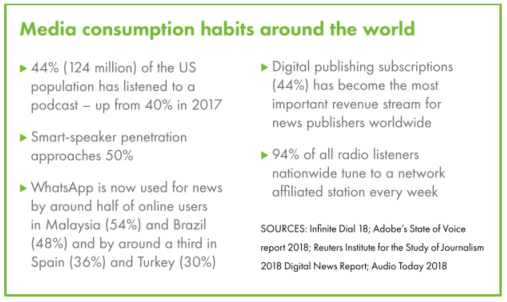Tech is increasing its presence in all aspects of the modern consumer’s life. From smart speakers to podcasts to app usage, the pace of adoption seems relentless. Yet at the same time, 60-80% of all publishers’ revenue is still generated from print.
“As print continues to thrive, it finds itself in a more complex ecosystem,” said Jon Watkins, a content marketing and media consultant who authored The Future of Media: How digital-to-print revenue models continue to shape the industry.
Watkins presented the report at a FIPP Insider event in Paris recently, according to FIPP’s Piet van Niekerk.
“Print isn’t for everybody in the same way podcasts are not for everybody…what successful publishers are doing is that they are considering what different audiences want,” Watkins explained. “They then segment their audiences not only by the type of content they want but also by the formats they want to receive that content.”
Created by FIPP in collaboration with UPM Communications Papers, the report “explores the value print continues to bring to publishing portfolios and how print fits into the wider publishing ecosystem,” van Niekerk explains.
Watkins examines the growth of reverse publishing, data-driven content, and print’s emerging role in the customer journey and how it fits into our media consumption habits.

Image source: FIPP
“Successful magazines have reinvented themselves as brands that serve their audience via a range of channels, of which print is just one,” Watkins explains. “Now, of course, multichannel means differentiating content to allow each channel to play to its strengths.”
Watkins also explores the shifting mindset of print publishers, many of whom have struggled with digital as “the enemy” in earlier stages of the disruption. Yet today we find print publications thriving, with success built on embracing that technology. The report cites Bauer Media’s Empire Magazine as a great example of this, with the interactive speaker embedded in the cover of its Deadpool 2 limited edition issue.
IKEA is another great example, with its “white noise and lavender” ad in their UAE catalog. Readers can remove the stiff paper ad, fold the tabs so it stands up, and plug it into a USB charging port. “When activated, the ad emitted a white noise frequency and a port released the aroma from the lavender-infused ink,” the report notes.
Imagine that happening just 10 years ago.
While tech and print partnerships like these are fun to discover, it’s important to remember that print revenue is the primary part of the revenue model. And the fake news epidemic and falling trust in social media has seen the pendulum swinging even more back to trusted printed.
The report is a fascinating look at what’s new in the world of print publishing and may open your eyes to just how valuable print is to the modern marketer. Print’s just fine, thanks, and finding new ways to thrive in the modern landscape.
